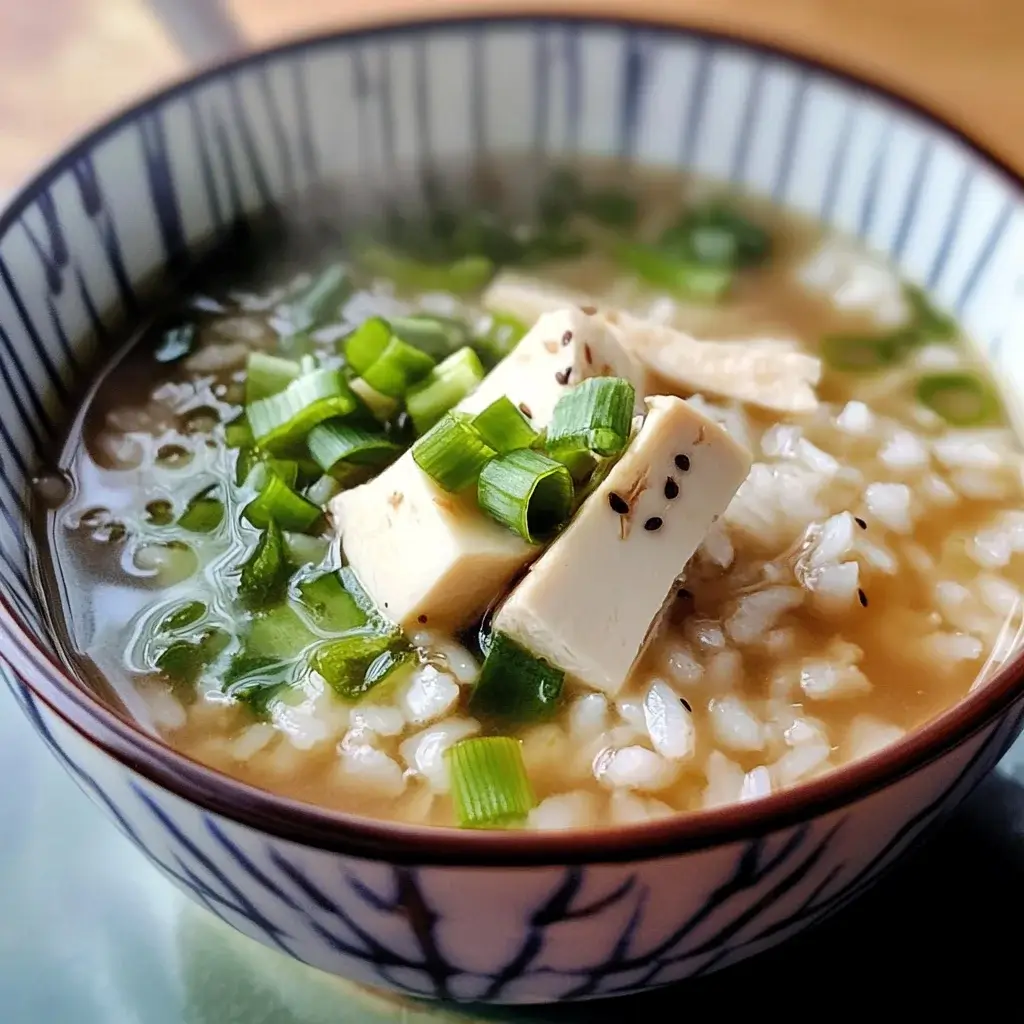There are some dishes that just instantly transport you to a place of comfort and warmth, and for our family, this Quick Miso Soup with Rice has become exactly that. I remember the first time I whipped it up on a chilly Tuesday evening; the kids were tired from school, my husband was late from work, and I needed something nourishing, fast, and universally appealing. I wasn’t sure how the distinct, savory taste of miso would go down with my youngest, who can be a bit picky. To my utter delight, not only did everyone slurp down their bowls with gusto, but my daughter even asked for seconds, proclaiming it her “new favorite soupy rice!” The subtle umami of the miso, the soft cubes of tofu, the tender grains of rice, and the slight oceanic hint from the wakame created a symphony of simple flavors that was both deeply satisfying and surprisingly light. It’s since become a go-to in our household, perfect as a quick lunch, a light dinner, or even a comforting starter. The beauty of this recipe lies in its simplicity and speed, without compromising on that authentic, soul-soothing taste. It’s proof that you don’t need hours in the kitchen to create something truly special and healthy.
Ingredients
- 4 cups Dashi Stock: (Approx. 960ml) The foundational broth of miso soup. You can use instant dashi granules dissolved in water for speed, or make your own from kombu (kelp) and katsuobushi (bonito flakes) for a deeper flavor. For a vegan version, use kombu and shiitake mushroom-based dashi.
- 1/2 cup Dried Wakame Seaweed: (Approx. 10g) This dried seaweed rehydrates quickly, adding a subtle briny flavor, silky texture, and valuable nutrients.
- 1 block (12-14 oz / 340-400g) Firm or Silken Tofu: Cut into ½-inch cubes. Firm tofu holds its shape well, while silken tofu offers a more delicate, custard-like texture. Choose based on your preference.
- 3-4 tablespoons Miso Paste: (Approx. 45-60ml) White (shiro) miso is milder and sweeter, red (aka) miso is more pungent and salty, and awase miso is a blend. Start with 3 tablespoons and adjust to your taste.
- 1 cup Cooked Rice: (Approx. 180-200g) Preferably short-grain Japanese rice, but any cooked white or brown rice will work. This is what makes the soup heartier.
- 2 Green Onions (Scallions): Thinly sliced, for garnish. Adds a fresh, mild oniony bite.
- Optional: 1 teaspoon Sesame Oil: Toasted sesame oil adds a nutty aroma and flavor if desired, drizzled at the end.
- Optional: Pinch of Shichimi Togarashi: A Japanese seven-spice blend for a touch of heat and complexity.
Instructions
- Prepare the Wakame: Place the dried wakame seaweed in a small bowl and cover it with lukewarm water. Let it soak for 5-10 minutes, or until it has fully rehydrated and expanded. Once rehydrated, drain it well and gently squeeze out any excess water. If the pieces are large, you can roughly chop them.
- Heat the Dashi: Pour the dashi stock into a medium saucepan and bring it to a gentle simmer over medium heat. Do not bring it to a rolling boil.
- Add Tofu and Wakame: Once the dashi is simmering, add the cubed tofu and the rehydrated wakame to the saucepan. Let them heat through for about 2-3 minutes. Again, maintain a gentle simmer.
- Prepare the Miso: Ladle about 1/2 cup of the warm dashi from the saucepan into a small bowl. Add the miso paste to this bowl. Whisk thoroughly with a fork or a small whisk until the miso paste is completely dissolved and there are no lumps. This step is crucial to prevent clumps of miso in your soup and ensures it incorporates smoothly.
- Incorporate Miso into Soup: Reduce the heat under the saucepan to low. Slowly pour the dissolved miso mixture into the soup. Stir gently to combine. It’s very important not to let the soup boil after adding the miso, as boiling can diminish its delicate flavor and kill its beneficial probiotic cultures. Heat it just until it’s warm enough to serve.
- Add Cooked Rice: Gently stir the cooked rice into the miso soup. Allow it to heat through for another minute or two. The rice will absorb some of the flavorful broth.
- Serve: Ladle the hot miso soup with rice into individual serving bowls.
- Garnish and Serve Immediately: Garnish with freshly sliced green onions. If desired, add a drizzle of toasted sesame oil or a pinch of shichimi togarashi for extra flavor and a little kick. Serve hot and enjoy the comforting warmth.
Nutrition Facts
- Servings: 2-3 hearty servings
- Calories per serving: Approximately 250-350 calories (This can vary based on the type of rice, amount of tofu, and specific miso paste used).
- Protein: A good source of plant-based protein, primarily from the tofu and miso paste, essential for muscle repair and satiety.
- Low in Saturated Fat: This soup is naturally low in unhealthy saturated fats, making it a heart-healthy option.
- Rich in Probiotics: Miso paste, being a fermented food, contains beneficial probiotics (if not boiled) that support gut health and digestion.
- Source of Minerals: Contains various minerals from seaweed (like iodine) and miso (like manganese and copper).
- Sodium Content: Be mindful that miso and dashi can contribute to sodium intake; adjust miso quantity if you are monitoring sodium closely.
Preparation Time
- Total Preparation and Cooking Time: Approximately 15-20 minutes.
- Prep Time: 5-7 minutes (soaking wakame, cubing tofu, slicing green onions, measuring ingredients).
- Cook Time: 10-13 minutes (heating dashi, adding ingredients, dissolving miso).
This makes it an exceptionally fast and convenient meal, perfect for busy weeknights or when you need a quick, nourishing pick-me-up.
How to Serve
This Quick Miso Soup with Rice is wonderfully versatile. Here are some ways to enjoy it:
- As a Light Main Meal:
- Its combination of rice, tofu, and broth makes it substantial enough for a light lunch or dinner on its own.
- Serve in generous individual bowls.
- Consider adding a soft-boiled or poached egg on top for extra protein and richness.
- As Part of a Traditional Japanese-style Meal:
- Serve in smaller bowls as a component of a larger spread.
- Pair it with dishes like:
- Grilled fish (e.g., salmon teriyaki, mackerel shioyaki)
- A small side salad with ginger dressing
- Japanese pickles (tsukemono)
- A dish of edamame
- As a Comforting Starter:
- Begin your meal with a small, warming bowl of this soup to whet the appetite.
- It’s particularly good before a sushi or sashimi course.
- Customized with Toppings:
- Beyond green onions, offer a selection of toppings on the side for everyone to customize their bowl:
- Toasted sesame seeds
- A few drops of chili oil or Sriracha for spice lovers
- Extra cubes of silken tofu for a creamier texture
- Thinly sliced shiitake mushrooms (sautéed briefly or added with tofu)
- A sprinkle of furikake (Japanese rice seasoning)
- Beyond green onions, offer a selection of toppings on the side for everyone to customize their bowl:
- Temperature Considerations:
- Always serve miso soup hot, but not boiling. The warmth is part of its comforting appeal.
- Presentation:
- Use traditional Japanese soup bowls if you have them for an authentic touch.
- Ensure the garnishes are fresh and vibrant to make the dish visually appealing.
Additional Tips
- Choosing Your Miso: The type of miso paste you use will significantly impact the soup’s flavor.
- Shiro Miso (White Miso): Mild, slightly sweet, and less salty. Great for beginners or if you prefer a lighter flavor. It’s versatile and widely available.
- Aka Miso (Red Miso): Fermented longer, it’s saltier, richer, and has a more pungent, umami-forward flavor. Use less of it initially and adjust.
- Awase Miso (Mixed Miso): A blend of white and red, offering a balanced flavor profile. A good all-purpose choice.
- Experiment to find your favorite! You can even blend different types for complexity.
- Dashi is Key: While instant dashi is convenient, making your own dashi from kombu (kelp) and katsuobushi (bonito flakes) will elevate your soup. For a vegan version, soak kombu and dried shiitake mushrooms in cold water for several hours or overnight, then gently heat. The quality of your dashi directly affects the final taste.
- Never Boil Miso: This is the golden rule of miso soup. Boiling miso paste not only diminishes its delicate, nuanced flavors and aromas but also destroys its beneficial live probiotic cultures. Always add the dissolved miso paste at the very end, with the heat turned low or off.
- Ingredient Variations: Feel free to customize your soup.
- Vegetables: Add thinly sliced carrots, daikon radish, Napa cabbage, or spinach. Cook harder vegetables in the dashi for a few minutes before adding tofu. Add leafy greens like spinach at the very end, as they wilt quickly.
- Mushrooms: Enoki, shiitake (fresh or rehydrated), or shimeji mushrooms are excellent additions. Sauté fresh mushrooms lightly before adding or add them to the dashi to cook.
- Protein: Instead of or in addition to tofu, you could add small pieces of cooked chicken, clams, or shrimp (add shrimp towards the end as they cook quickly).
- Rice Considerations:
- Using leftover cooked rice is perfect for this recipe.
- Short-grain Japanese rice (like Koshihikari or Calrose) is traditional and has a nice texture, but basmati or jasmine rice will also work. Brown rice can be used for added fiber, but it has a nuttier flavor and chewier texture.
- If you prefer, you can serve the miso soup alongside a separate bowl of rice, allowing individuals to add rice to their soup as they eat.
- Adjusting Consistency and Flavor:
- If you like a thicker soup, you can add a bit more rice or even a slurry of potato starch (mix a teaspoon with cold water, then stir into the simmering broth before adding miso).
- Taste and adjust seasoning. If it’s too bland, add a little more dissolved miso or a tiny dash of soy sauce (use sparingly). If too salty, dilute with a bit more plain hot water or dashi.
- Storage and Reheating:
- Miso soup is best enjoyed fresh. However, if you have leftovers, store them in an airtight container in the refrigerator for up to 1-2 days.
- Reheat gently on the stovetop over low heat. Do not bring it to a boil to preserve the miso’s flavor and beneficial properties. The rice may absorb more liquid upon storage, so you might need to add a splash more dashi or water when reheating. Avoid microwaving if possible, as it can heat unevenly and potentially boil the miso.
- Making it Kid-Friendly:
- Use shiro (white) miso for a milder, sweeter flavor that children often prefer.
- Cut tofu into small, fun shapes using cookie cutters if you have the time.
- Ensure the soup is not too hot when serving to little ones.
- Let them participate in adding their own (mild) garnishes like a few extra grains of rice or small pieces of nori.
FAQ Section
- Q: Can I make this Miso Soup with Rice vegan?
A: Absolutely! The core components like miso, tofu, rice, and wakame are naturally vegan. The key is to ensure your dashi stock is vegan. Traditional dashi often uses katsuobushi (bonito flakes). For a vegan version, use dashi made solely from kombu (kelp) or a combination of kombu and dried shiitake mushrooms. Many instant dashi products also offer vegan/vegetarian options – just check the label. - Q: Is this recipe gluten-free?
A: Generally, yes, but it depends on the specific ingredients you use. Rice, tofu, wakame, and most pure miso pastes are gluten-free. However, some miso pastes (especially barley miso or “mugi miso”) contain gluten. Also, some soy sauces or dashi powders might have gluten-containing additives. Always check the labels of your miso paste, dashi, and any soy sauce if you’re strictly gluten-free. - Q: What’s the difference between firm and silken tofu, and which is better for this soup?
A: Firm tofu has less water content, holds its shape well when cubed and simmered, and has a slightly chewier texture. Silken tofu is very soft, smooth, and custard-like; it breaks apart more easily but offers a delicate texture. For this recipe where rice is also present, firm tofu is often preferred as it maintains its integrity. However, silken tofu is also a traditional and delicious choice if you prefer its softer consistency. It’s largely a matter of personal preference. - Q: Can I prepare any parts of this soup ahead of time?
A: Yes, you can do some prep work to save time. You can cook the rice in advance and store it in the fridge. Tofu can be cubed and kept in water in the fridge. Green onions can be sliced. You can even make a larger batch of dashi stock and store it. However, assemble and add the miso paste to the soup just before serving for the best flavor and to preserve probiotics. - Q: My miso soup sometimes tastes too salty or bland. How can I fix this?
A: Miso paste varies greatly in saltiness.- Too Salty: If it’s too salty, you can dilute it with a bit more plain hot water or unsalted dashi stock. Next time, use less miso paste or switch to a milder variety like shiro miso.
- Too Bland: If it’s bland, the most common reason is not enough miso or weak dashi. Try whisking a little more miso paste (dissolved in some warm broth first) into the soup. Ensure your dashi is flavorful. A tiny pinch of salt or a dash of soy sauce can also lift the flavors, but add miso first.
- Q: I don’t have dashi granules or ingredients to make dashi from scratch. Are there any substitutes?
A: While dashi is fundamental to authentic miso soup, in a pinch, you could use a light vegetable broth or even chicken broth (though this will significantly change the flavor profile and it won’t be traditional or vegan/vegetarian). If using vegetable broth, look for a low-sodium one and you might want to add a small piece of kombu while it simmers to impart some umami. The result will be different, but still a tasty soup. However, dashi granules are widely available and a good pantry staple for quick miso soup. - Q: How long does miso paste last once opened?
A: Opened miso paste, when stored properly in an airtight container in the refrigerator, can last for a surprisingly long time – often several months up to a year. The high salt content acts as a preservative. Some people even place a piece of plastic wrap directly on the surface of the miso before sealing the container to minimize oxidation. Its flavor might change subtly over very long periods, but it generally remains safe to use. Always check for any off-smells or mold, though this is rare if stored correctly. - Q: Besides tofu and wakame, what other classic additions go into miso soup?
A: Traditional miso soup is beautifully adaptable to seasonal ingredients. Some classic additions include:- Root Vegetables: Daikon radish, carrots, potatoes, sweet potatoes (cut small and simmered until tender).
- Mushrooms: Shiitake, enoki, shimeji, nameko (nameko mushrooms make the soup slightly viscous).
- Leafy Greens: Spinach, komatsuna (Japanese mustard spinach), Napa cabbage.
- Other: Aburaage (deep-fried tofu pouches), clams (asari miso soup is popular), negi (Japanese long onion), seasonal fish. The key is to cook any harder ingredients in the dashi before adding the miso.






